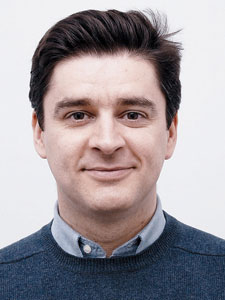Tiago V. Maia
 University of Lisbon, Portugal, and Columbia University
University of Lisbon, Portugal, and Columbia University
What does your research focus on?
In terms of psychological processes, I am interested in automatic behaviors, such as habits, and emotional responses, such as fear, with an emphasis on how such behaviors and responses are learned and can be unlearned. In terms of brain function, I am interested in the structures that subserve and modulate these psychological processes, especially the basal ganglia, prefrontal cortex, amygdala, and neuromodulatory systems. My research program also includes a substantial translational component that investigates three disorders that involve disturbances in these processes and neural substrates: Tourette syndrome, obsessive-compulsive disorder, and attention-deficit/hyperactivity disorder. I investigate these topics using a combination of neurocomputational modeling, brain imaging (especially fMRI), and behavioral experimentation.
What drew you to this line of research and why is it exciting to you?
I highly value the role of good, formal theories to understand the brain and behavior, and there are excellent computational theories of learning, so investigating topics related to learning was a natural choice for me. During the course of my PhD, I became fascinated by the ability of relatively simple mathematical/computational learning theories to provide unified explanations for large bodies of psychological and neuroscientific findings. I also realized that those theories could be applied to understanding what is going on in psychopathology, and that has perhaps been the most exciting and rewarding aspect of this work. The hope of having a direct, meaningful impact in improving the lives of the millions of people who suffer every day with the disorders that I study is a powerful motivator indeed!
Who were/are your mentors or scientific influences?
I learned a tremendous amount about both good science and the role of modeling in psychology and neuroscience from my PhD advisor, James McClelland. I learned a great deal about brain imaging and psychiatric disorders from my postdoctoral advisor, Bradley Peterson. I have also had many wonderfully stimulating and informative interactions with Michael Frank about models of the basal ganglia and computational psychiatry more generally. Other salient scientific influences include Jonathan Cohen, who was doing computational psychiatry before almost anyone else was talking about it, and Peter Dayan, who has had a leading role in the application of reinforcement learning to psychology and neuroscience.
I also admire the work that was done in the middle of the 20th century translating learning principles investigated in experimental-psychology labs to clinical applications. Such work led to the development of important treatments (e.g., exposure and response prevention) that were strongly grounded in experimental and theoretical basic-science work. Unfortunately, the research agendas of experimental and clinical psychology labs subsequently started to diverge (with, for example, cognitive therapy having little, if any, grounding in research in cognitive psychology). I hope that my work can help to reverse that trend, bringing back a tight integration of basic science and clinical applications — but now with the addition of formal models and an integrated understanding of brain and behavior.
What’s your future research agenda?
We have just started to scratch the surface of an immense well of opportunities for computational models to provide new insights into psychiatric disorders. I hope that my work, together with the work of others who are pursuing similar approaches, will contribute to firmly establish computational psychiatry as a novel, paradigm-shifting approach to studying the neurobehavioral bases of psychiatric disorders — one built on close interactions between empirical work and formal theories. But the real “prize” would be to be able to show that this approach can lead to clinically meaningful advances. Admittedly, these are ambitious objectives, but they are my long-term vision. If they are successful, they could radically change research in psychiatry as we know it.
What publication are you most proud of?
I will exhibit a bit of a recency effect and select the following:
Maia, T. V., & Frank, M. J. (2011). From reinforcement learning models to psychiatric and neurological disorders. Nature Neuroscience, 14, 154–162.
This article seeks to demonstrate how a small set of computational reinforcement-learning principles can explain a broad range of neurobehavioral findings in several psychiatric and neurological disorders, and as such it illustrates the kind of integrative and unifying theorizing that I find most appealing. We are fortunate to live in an age where the number of scientists and studies in any given topic is extremely large, but the result of this collective effort sometimes seems like a patchwork of somewhat disjointed empirical findings. We need formal theories in psychology, neuroscience, and psychiatry that can bring “order” into this apparent chaos. This article tries to illustrate how that is now within our reach and can lead to new insights into psychiatric and neurological disorders.





APS regularly opens certain online articles for discussion on our website. Effective February 2021, you must be a logged-in APS member to post comments. By posting a comment, you agree to our Community Guidelines and the display of your profile information, including your name and affiliation. Any opinions, findings, conclusions, or recommendations present in article comments are those of the writers and do not necessarily reflect the views of APS or the article’s author. For more information, please see our Community Guidelines.
Please login with your APS account to comment.